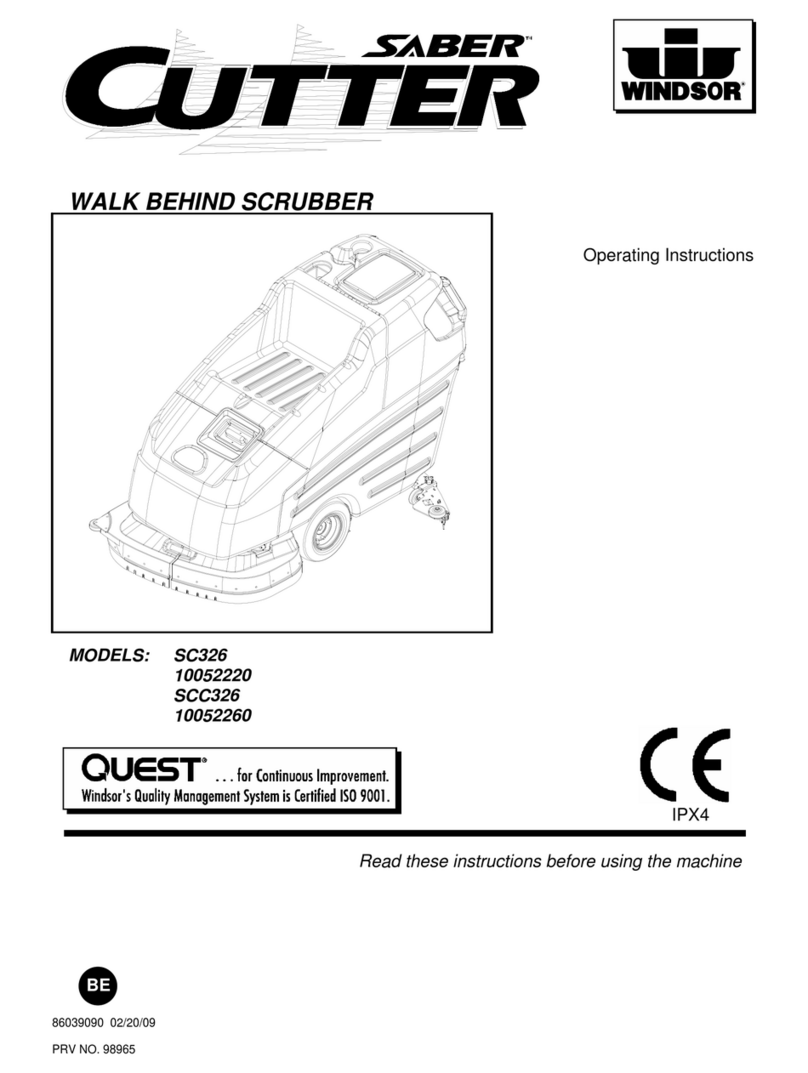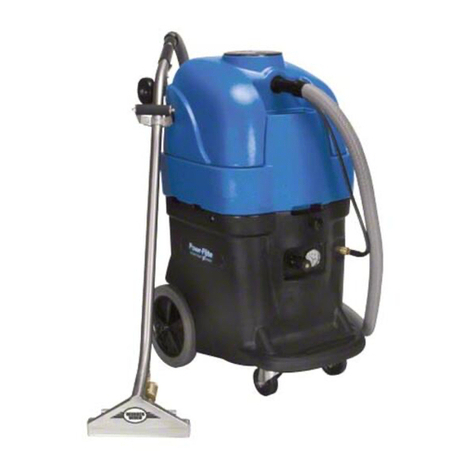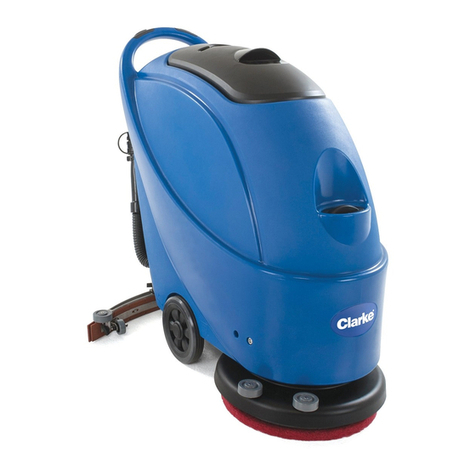Deutsch 7
ÎZum Entriegeln der Feststellbremse
Entriegelungshebel nach unten drü-
cken.
Gefahr
Unfallgefahr durch wegrollendes Gerät.
Nach Ende des Schiebevorgangs den Ent-
riegelungshebel unbedingt wieder nach
oben stellen und damit die Feststellbremse
wieder aktivieren.
Hinweis
Für eine sofortige Außerbetriebnahme aller
Funktionen Fuß vom Fahrpedal nehmen,
Not-Aus-Taster drücken und Schlüssel-
schalter auf „0“ drehen.
ÎSchrauben lösen und Holzkäfig entfer-
nen.
ÎPackband aus Kunststoff zerschneiden
und Folie entfernen.
ÎFixierung an den Rädern entfernen.
ÎBretter auf die Kante der Palette legen.
Bretter so ausrichten, dass sie vor den
Rädern des Gerätes liegen. Bretter mit
den Schrauben befestigen.
ÎHolzklötze zur Arretierung der Räder
entfernen und unter die Rampe schie-
ben.
ÎLenkrad aufstecken und Vorderrad ge-
rade ausrichten.
ÎLenkrad abziehen, ausrichten und wie-
der aufstecken.
ÎLenkrad mit beiliegender Mutter befes-
tigen.
ÎAbdeckung in das Lenkrad einstecken.
ÎAuf die Standfläche treten und mit dem
linken Fuß das Sicherheitspedal ge-
drückt halten.
ÎNot-Aus-Taster durch Drehen entrie-
geln.
ÎSchlüsselschalter auf „1“ stellen.
ÎFahrtrichtung mit dem Fahrtrichtungs-
schalter am Bedienpult einstellen.
ÎKleinsten Geschwindigkeitsbereich mit
Schalter Geschwindigkeit auswählen.
ÎEntriegelungstaste drücken.
ÎZum Fahren das Fahrpedal vorsichtig
betätigen und langsam von der Palette
herunterfahren.
ÎSchlüsselschalter auf „0“ stellen.
Vor Inbetriebnahme müssen die Bürsten
montiert werden (siehe „Wartungsarbei-
ten“).
Gefahr
Längere Benutzungsdauer des Gerätes
kann zu vibrationsbedingten Durchblu-
tungsstörungen in den Händen führen.
Eine allgemein gültige Dauer für die Benut-
zung kann nicht festgelegt werden, weil
diese von mehreren Einflussfaktoren ab-
hängt:
– Persönliche Veranlagung zu schlechter
Durchblutung (häufig kalte Finger, Fin-
gerkribbeln).
– Niedrige Umgebungstemperatur. War-
me Handschuhe zum Schutz der Hän-
de tragen.
– Festes Zugreifen behindert die Durch-
blutung.
– Ununterbrochener Betrieb ist schlech-
ter als durch Pausen unterbrochener
Betrieb.
Bei regelmäßiger, langandauernder Benut-
zung des Gerätes und bei wiederholtem
Auftreten entsprechender Anzeichen (zum
Beispiel Fingerkribbeln, kalte Finger) emp-
fehlen wir eine ärztliche Untersuchung.
Hinweis
Für eine sofortige Außerbetriebnahme aller
Funktionen Fuß vom Fahrpedal nehmen,
Not-Aus-Taster drücken und Schlüssel-
schalter auf „0“ drehen.
ÎWartungsarbeiten „zu Beginn einer Be-
triebswoche“ ausführen (siehe Kapitel
„Pflege und Wartung“).
Gefahr
Unfallgefahr. Vor jedem Betrieb muss die
Funktion der Feststellbremse in der Ebene
überprüft werden.
ÎSchlüsselschalter auf „0“ stellen.
ÎNot-Aus-Taster drücken.
Lässt sich das Gerät nun von Hand schieben,
ist die Festellbremse nicht funktionsfähig.
ÎEntriegelungshebel der Feststellbrem-
se nach oben drücken.
Kann das Gerät immer noch von Hand ge-
schoben werden, ist die Feststellbremse
defekt. Gerät stilllegen und den Kunden-
dienst rufen.
Gefahr
Unfallgefahr. Zeigt das Gerät beim Fahren
auf einer Gefällstrecke keine ausreichende
Bremswirkung, Not-Aus-Taster drücken:
ÎDeckel des Frischwassertanks öffnen.
ÎFrischwasser (maximal 60 °C) bis
15 cm unter die Oberkante des Tanks
einfüllen.
ÎReinigungsmittel einfüllen.
ÎDeckel des Frischwassertanks schlie-
ßen.
Hinweis
Vor der ersten Inbetriebnahme Frischwas-
sertank vollständig füllen, um das Wasser-
leitungssystem zu entlüften.
Bei leerem Leitungssystem kann es bis zu
2 Minuten dauern, bis Reinigungslösung
am Reinigungskopf austritt.
몇Warnung
Beschädigungsgefahr. Nur empfohlene
Reinigungsmittel verwenden. Für andere
Reinigungsmittel trägt der Betreiber das er-
höhte Risiko hinsichtlich der Betriebssi-
cherheit und Unfallgefahr.
Nur Reinigungsmittel verwenden, die frei von
Lösungsmitteln, Salz- und Flusssäure sind.
Hinweis
Keine stark schäumenden Reinigungsmit-
tel verwenden.
Empfohlene Reinigungsmittel:
Um sich mit dem Gerät vertraut zu machen,
erste Fahrversuche auf einem freien Platz
durchführen.
Gefahr
Kippgefahr bei zu großen Steigungen.
ÎIn Fahrtrichtung nur Steigungen bis zu
10% befahren.
Kippgefahr bei schneller Kurvenfahrt.
Schleudergefahr bei nassem Boden.
ÎIn Kurven langsam fahren.
Kippgefahr bei instabilem Untergrund.
ÎDas Gerät ausschließlich auf befestig-
tem Untergrund bewegen.
Kippgefahr bei zu großer seitlicher Nei-
gung.
ÎQuer zur Fahrtrichtung nur Steigungen
bis maximal 10% befahren.
Abladen
Bürsten montieren
Betrieb
Feststellbremse prüfen
Bremsen
Betriebsstoffe einfüllen
Frischwasser
Reinigungsmittel
Anwendung Reini-
gungsmit-
tel
Unterhaltsreinigung aller
wasserbeständigen Böden
RM 780
RM 746
Unterhaltsreinigung von
glänzenden Oberflächen
(z. B. Granit)
RM 755 es
Unterhaltsreinigung und
Grundreinigung von Indus-
triefußböden
RM 69 ASF
Unterhaltsreinigung und
Grundreinigung von Fein-
steinzeugfliesen
RM 753
Unterhaltsreinigung von
Fliesen im Sanitärbereich
RM 751
Reinigung und Desinfekti-
on im Sanitärbereich
RM 732
Entschichtung aller alkali-
beständigen Böden (z. B.
PVC)
RM 752
Entschichtung von Lino-
leumböden
RM 754
Fahren



















































